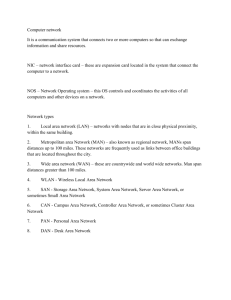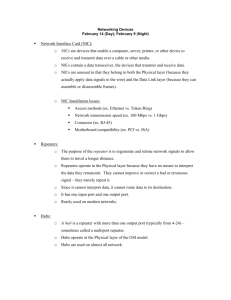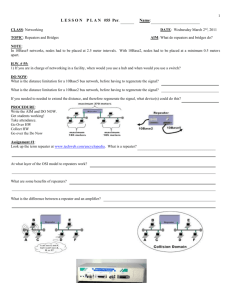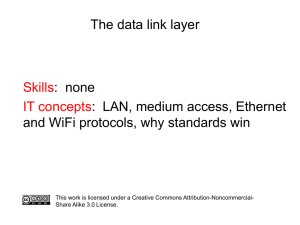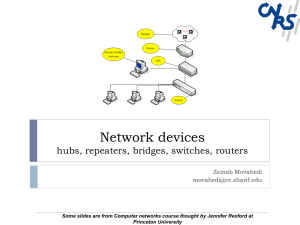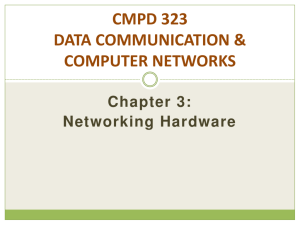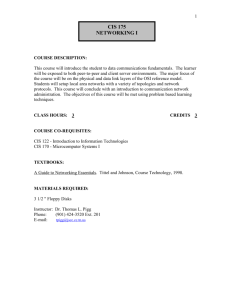8461Computer Network-1
advertisement
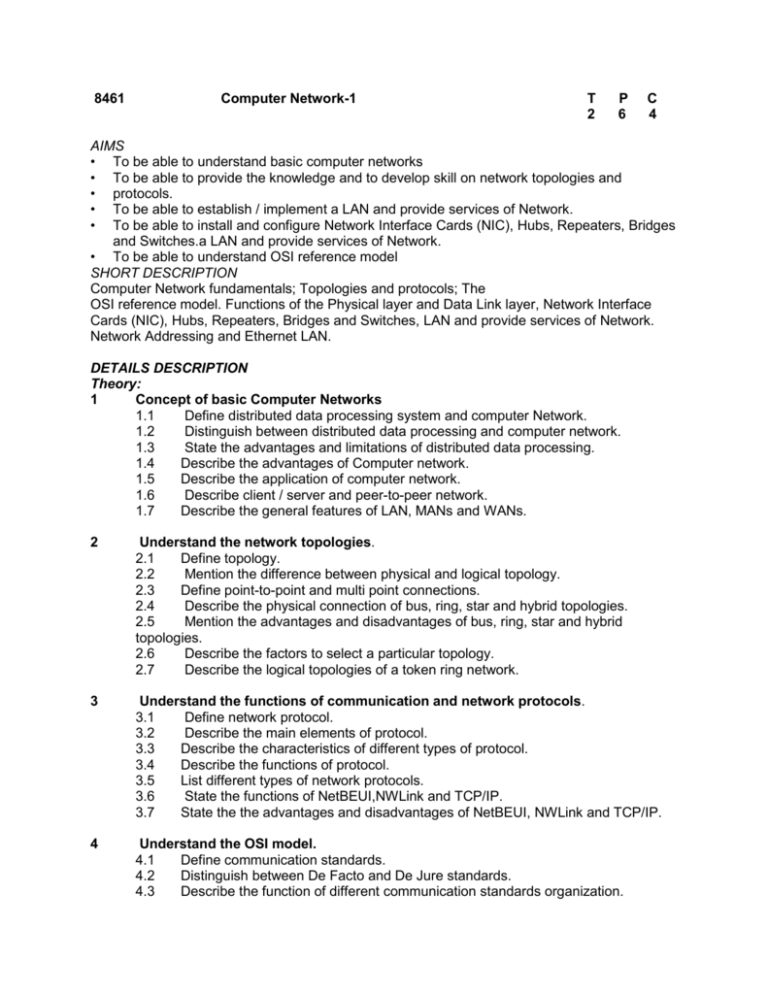
8461 Computer Network-1 T 2 P 6 C 4 AIMS • To be able to understand basic computer networks • To be able to provide the knowledge and to develop skill on network topologies and • protocols. • To be able to establish / implement a LAN and provide services of Network. • To be able to install and configure Network Interface Cards (NIC), Hubs, Repeaters, Bridges and Switches.a LAN and provide services of Network. • To be able to understand OSI reference model SHORT DESCRIPTION Computer Network fundamentals; Topologies and protocols; The OSI reference model. Functions of the Physical layer and Data Link layer, Network Interface Cards (NIC), Hubs, Repeaters, Bridges and Switches, LAN and provide services of Network. Network Addressing and Ethernet LAN. DETAILS DESCRIPTION Theory: 1 Concept of basic Computer Networks 1.1 Define distributed data processing system and computer Network. 1.2 Distinguish between distributed data processing and computer network. 1.3 State the advantages and limitations of distributed data processing. 1.4 Describe the advantages of Computer network. 1.5 Describe the application of computer network. 1.6 Describe client / server and peer-to-peer network. 1.7 Describe the general features of LAN, MANs and WANs. 2 Understand the network topologies. 2.1 Define topology. 2.2 Mention the difference between physical and logical topology. 2.3 Define point-to-point and multi point connections. 2.4 Describe the physical connection of bus, ring, star and hybrid topologies. 2.5 Mention the advantages and disadvantages of bus, ring, star and hybrid topologies. 2.6 Describe the factors to select a particular topology. 2.7 Describe the logical topologies of a token ring network. 3 Understand the functions of communication and network protocols. 3.1 Define network protocol. 3.2 Describe the main elements of protocol. 3.3 Describe the characteristics of different types of protocol. 3.4 Describe the functions of protocol. 3.5 List different types of network protocols. 3.6 State the functions of NetBEUI,NWLink and TCP/IP. 3.7 State the the advantages and disadvantages of NetBEUI, NWLink and TCP/IP. 4 Understand the OSI model. 4.1 Define communication standards. 4.2 Distinguish between De Facto and De Jure standards. 4.3 Describe the function of different communication standards organization. 4.4 4.5 4.6 4.7 4.8 State the function of Forums and Regulatory Agencies. State the function of IEEE in the field of communication and computer Network. State the ISO issues. Describe the reason for developing OSI Model. Describe the functions of each layer of the OSI reference model. 5 Understand the functions of the Physical layer and Data Link layer of the OSI reference model. 5.1 Draw the position diagram of Physical layer in the Internet model. 5.2 Describe the functions and services of Physical layer. 5.3 Draw the position diagram of Data link layer in the Internet model 5.4 Describe the duties and responsibilities of Data link layer. 5.5 State the functions of LLC and MAC sublayer. 5.6 Describe the function of network connectivity devices used in Physical and Data link layers (Repeater, modems, Hub/ Switch and bridge) 6 Understand Network Interface Cards (NIC) 6.1 State the role of NIC. 6.2 Describe the network address. 6.3 Mention the points that agree both the sending and receiving NICs. 6.4 State the importance of base memory address for NIC. 6.5 Mention the important points to maintain the compatibility among NIC, bus and cables. 6.6 Describe the factors that enhanced the network performance. 7 Understand the Hubs, Repeaters, Bridges and Switches. 7.1 Describe the functions of Hubs, Repeaters, Bridges and Switches in network. 7.2 Mention the types of Hubs. 7.3 Describe the important features of passive, active and intelligent Hubs. 7.4 Describe the important features of Repeaters, Bridges and Switches. 7 .5 Differentiate between Bridges, Repeaters and Switches. 8 Understand Network and IP Addressing. 8.1 Define Network Addressing. 8.2 State the format of physical address of a NIC. 8.3 Define IP. 8.4 Describe the IP address Formats of Class A, B, C, D, and E with example. 8.5 Describe Subnets and Subnet Masks. 8.6 Define IPv6. 9 Understand operation and features of Ethernet LAN. 9.1 State the background of Ethernet Technology. 9.2 Describe the frame format of Ethernet /IEEE-802.3 9.3 Describe the features of Physical layer of 10-Mbps Ethernet (PLS, AUI and MAU). 9.4 Describe the implementation features of Traditional Ethernet (10Base5, 10Base2, 10Base-T, and 10Base-FL). 9.5 Describe the implementation features of Traditional Ethernet (10Base5, 10Base2, 10Base-T, and 10Base-FL). 9.6 Describe the implementation features of FAST Ethernet (100Base-TX, 100BaseFX and 100Base-T4). 9.7 Describe the implementation features of Gigabit Ethernet (1000Base-SX, 1000Base-LX, 1000Base-CX and 1000Base-T). Practical: 1 To identify the Network Cards, Tools, Tester and Accessories (modems, Hub/ Switch, Repeater, Bridge etc.) 2 To connect RJ45 Connector with UTP Cable in the form of straight through /Cross Over. 3 To establish a Pear to Pear LAN 4 To install NIC into the PC 5 To check the MAC address of the NIC 6 Connect cable connector with PC & Hub/Switch 7 Configure the TCP/IP in each PC 8 Test the connectivity of the PCs 9 Perform the task to Work with a Peer to peer LAN environment for simple data communication. 10 Share the folders / secondary memory. 11 Share a printer or any other resources. REFERENCE BOOKS 1 Data communications and Networking – Behrouz A. Forouzan 2 Data and Computer Communications-William Stallings 3 Fundamentals of comunication-M. Shamim Kaiser and associates 4 Local Area Networking – S. K Basandra. 5 Computer Networks – Uyless Black. 6 Computer Networks – Andrew S. Tanenbaum. 7 MCSE Windows & Networking Essential – Joe Casad.
